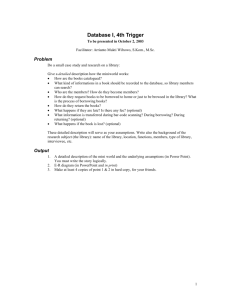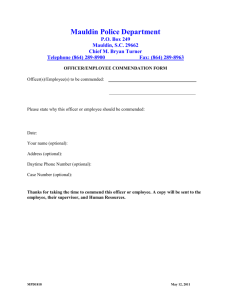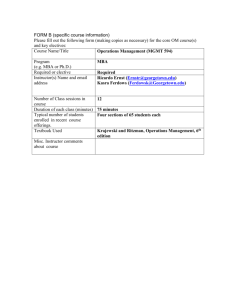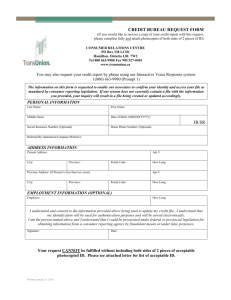David Bryce BM 481 Syllabus Fall 2008 BM 481
advertisement
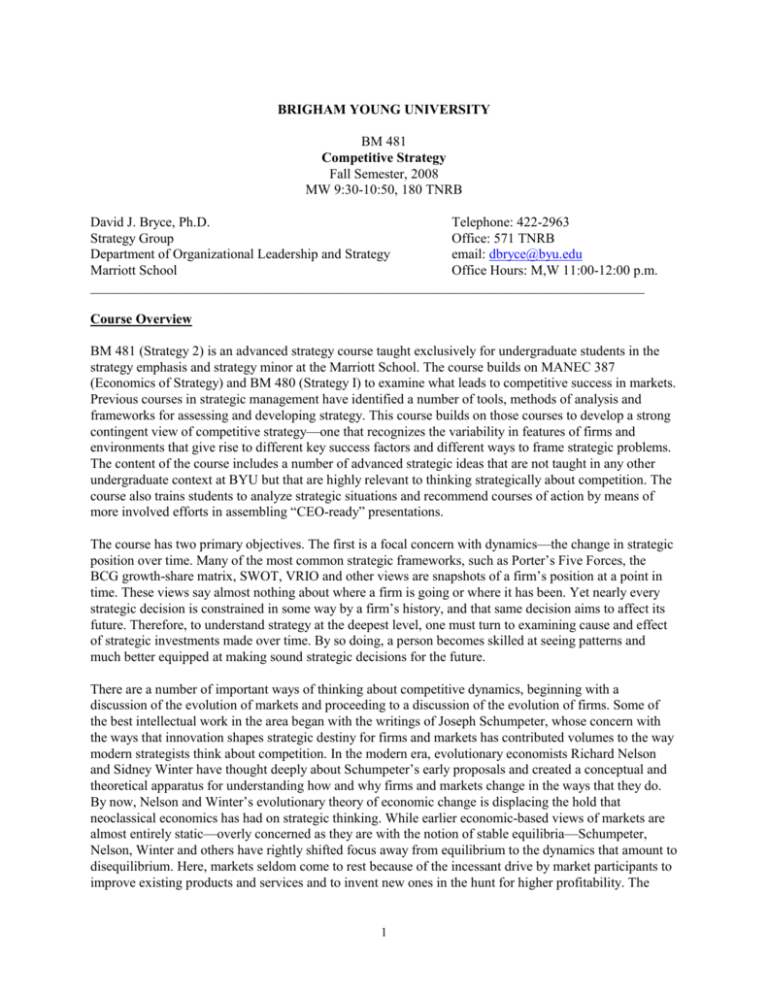
BRIGHAM YOUNG UNIVERSITY BM 481 Competitive Strategy Fall Semester, 2008 MW 9:30-10:50, 180 TNRB David J. Bryce, Ph.D. Telephone: 422-2963 Strategy Group Office: 571 TNRB Department of Organizational Leadership and Strategy email: dbryce@byu.edu Marriott School Office Hours: M,W 11:00-12:00 p.m. ________________________________________________________________________________ Course Overview BM 481 (Strategy 2) is an advanced strategy course taught exclusively for undergraduate students in the strategy emphasis and strategy minor at the Marriott School. The course builds on MANEC 387 (Economics of Strategy) and BM 480 (Strategy I) to examine what leads to competitive success in markets. Previous courses in strategic management have identified a number of tools, methods of analysis and frameworks for assessing and developing strategy. This course builds on those courses to develop a strong contingent view of competitive strategy—one that recognizes the variability in features of firms and environments that give rise to different key success factors and different ways to frame strategic problems. The content of the course includes a number of advanced strategic ideas that are not taught in any other undergraduate context at BYU but that are highly relevant to thinking strategically about competition. The course also trains students to analyze strategic situations and recommend courses of action by means of more involved efforts in assembling “CEO-ready” presentations. The course has two primary objectives. The first is a focal concern with dynamics—the change in strategic position over time. Many of the most common strategic frameworks, such as Porter’s Five Forces, the BCG growth-share matrix, SWOT, VRIO and other views are snapshots of a firm’s position at a point in time. These views say almost nothing about where a firm is going or where it has been. Yet nearly every strategic decision is constrained in some way by a firm’s history, and that same decision aims to affect its future. Therefore, to understand strategy at the deepest level, one must turn to examining cause and effect of strategic investments made over time. By so doing, a person becomes skilled at seeing patterns and much better equipped at making sound strategic decisions for the future. There are a number of important ways of thinking about competitive dynamics, beginning with a discussion of the evolution of markets and proceeding to a discussion of the evolution of firms. Some of the best intellectual work in the area began with the writings of Joseph Schumpeter, whose concern with the ways that innovation shapes strategic destiny for firms and markets has contributed volumes to the way modern strategists think about competition. In the modern era, evolutionary economists Richard Nelson and Sidney Winter have thought deeply about Schumpeter’s early proposals and created a conceptual and theoretical apparatus for understanding how and why firms and markets change in the ways that they do. By now, Nelson and Winter’s evolutionary theory of economic change is displacing the hold that neoclassical economics has had on strategic thinking. While earlier economic-based views of markets are almost entirely static—overly concerned as they are with the notion of stable equilibria—Schumpeter, Nelson, Winter and others have rightly shifted focus away from equilibrium to the dynamics that amount to disequilibrium. Here, markets seldom come to rest because of the incessant drive by market participants to improve existing products and services and to invent new ones in the hunt for higher profitability. The 1 economic world of the neoclassicists is one in which firms use market power to maintain dominance and secure profit. The economic world of Schumpeter is one in which firms constantly innovate, change, and improve products and services, and this leads to rising and falling fortunes for firms as they navigate constantly shifting terrain in the competitive milieu. The latter frame is most reflective of current market reality and it will be the dominant conceptual frame throughout the course. While we continue to cover important content, a second important objective of the course provides opportunities for you to bring together the many perspectives that you’ve gathered from business and strategy coursework to develop detailed points of view about actions that should be taken in particular cases. In this regard, the course aims to mimic the experience of an external consultant who is advising a client on a significant strategic issue. Students will spend a good deal of time working in teams on particular cases, developing hypotheses, performing analyses, and then putting it all together in persuasive presentations to be shared with the class and turned in for credit. Making such arguments and presentations is the primary work of those with strategic skills—nearly independent of the setting in which the skills are exercised—and so developing these skills now will pay large dividends for students in the future. Learning Objectives The ultimate objective of the course is for you to further develop your abilities in strategic analysis and formulation. To this, you will further develop a foundation upon which to conceive of creative strategic options for firms both large and small and to understand which options among many are likely to be the most successful in leading to superior performance for the firm. Following are specific learning objectives: 1. 2. 3. 4. 5. Appreciate the complexity, nuance, and differences across contexts in strategic situations Understand competitive, especially Schumpeterian and evolutionary, dynamics Develop effective strategy for firms through competent analysis and logic Learn to develop “CEO-ready” strategy presentations to express points of view on complex cases Demonstrate collaborative and participatory skills These learning objectives will be primarily assessed through evaluations of presentations, written papers, and class participation. Course Format The course will utilize on-line and packet readings for student preparation, lecture, class discussion, and case discussion. Most of the readings are available in a reading packet available through the bookstore. Additional readings, especially optional readings are posted on Blackboard. From time to time, for optional reading, you may want to access a Harvard Business Review article on line. You can do this within the Business Source Premier database at the library. Access this database online by going to the library main website, selecting databases, and going to the Business Source premier database. Search by author and journal and you can easily find articles. “Optional” reading is optional and often difficult, but nevertheless encouraged, as it will give you deeper understanding of concepts and will likely help you on the thought paper assignment and the final exam (see below). 2 Grading will be as follows: 1. 2. 3. 4. 5. 6. Class Participation Powerpoint case reports (4) Case presentations (2) Thought paper Team assignments Final exam 10% 25% 20% 15% 15% 15% Class Participation (10%) There will be many opportunities for discussion in class. What I’m looking for in class participation are salient comments that contribute to the discussion by providing insights that are not immediately obvious or that move the discussion forward in meaningful ways. The best way to ensure high performance on the participation grade is to come prepared to class having read the articles assigned for that day carefully and having thought about implications of the concepts in those articles. Pointing out how the concepts could apply to a current event in the business world is especially helpful. The discussion questions outlined for each class session help point to the nature of the discussion that we will be having and can help you prepare for class. Also included in the class participation grade will be a teammate assessment of your contributions and involvement in team work. Powerpoint case reports (4) (25%) We will analyze four cases during the semester. Each case has two days assigned to it: An initial “work day” in which we work together in class and in teams to identify relevant business problems, hypotheses, and storylines for the case; and a second day in which teams present their findings. On each presentation day, only about four groups will present according to an assigned schedule, but each team must turn in a powerpoint presentation document on that day, even if the team is not presenting. Altogether, each team turns in four powerpoint documents during the semester and each team presents two of those documents. Powerpoint documents must manifest the principles of hypothesis based problem-solving and good presentation design—concepts the course aims to help you develop. The presentations must supply wellthought out analysis of the issues in the case including both qualitative and quantitative features that are regarded as crucial to resolving the case situation. I will post the case presentation schedule after teams are organized. Case Presentations (2) (20%) Each team presents their findings for two cases during the semester. These oral presentations are expected to be professional, well-orchestrated and “client-ready” in the sense that the class is to be treated as the board or management of the company in the case. Due to time constraints, each presentation will only be about 15 minutes long plus five minutes for questions. Therefore, the presentations must be brief and to the point Thought Paper (15%) Each student will turn in a thought paper reflecting on Schumpeterian competition, evolutionary economics, and/or rugged landscapes and how these concepts apply to some aspect of life, or to some business situation of which the student is aware. Here, I’m looking for deep thinking about how these perspectives (or just one perspective) inform the student’s view of the situation they select, along with the implications or conclusions that one draws from the application of the perspective. Papers will be evaluated on my perception of how well you understand these concepts and therefore how well you are able to apply them and see them at work in an actual situation. Papers are to be no more than 8 doublespaced pages (12 point font) and may be less. Sourcing of research articles or bibliography is not necessary. 3 Team Assignments (15%) There are various team assignments that are noted in the class schedule below and there may be additional assignments that I add as the semester proceeds. All of these assignments are grouped together for the team assignment portion of the grade. Final Exam (15%) The final exam will be purely conceptual in orientation and taken by each student. It will ask you to comment about various different principles or concepts from the course and will be given during the final exam period. 4 Quick View Course Outline (Subject to Change): Session Date Module Topic Readings 1 Sep 3 Problem-solving Course Introduction and Overview 2 Sep 8 Hypothesis based problem-solving Assignment Due Lecture notes on competitive advantage Lecture notes on structured Logic tree for problem-solving 3 4 Sep 10 Sep 15 improving Marriott School rankings Diagnosing opportunities for improvement The new leader’s guide to Case work day Matching Dell (9-704-476) Going-in problem diagnosing the business, Gottfredson (HBR, R0802C) statement and hypotheses for Dell 5 Sep 17 6 Sep 22 Lecture notes on Structuring presentations structuring presentations 7 Origins of Strategy Sep 24 Strategy on rugged landscapes (Review on-line if needed) What is Strategy, Porter, HBR, see especially discussion of “fit” of activities (Optional) BB, Levinthal, Adaptation on Rugged Landscape reading Matching Dell (9-704-476) Matching Dell case Case presentation day powerpoints 8 Sep 29 An options-led approach to strategic An options-led approach to Strategic options for choices making strategic choices, the Marriott School Rivkin, (702433) 9 Oct 1 Case work day Lycos: The Tripod Decision (702435) 10 Oct 6 Finding empty strategy space Blue Ocean Strategy, Kim and Mauborgne, HBR (R0410D) (Optional on-line review) Strategies to Crack Wellguarded Markets, Bryce and Dyer, HBR 11 Oct 8 Lycos: The Tripod Case presentation day Decision (702435) 12 Oct 13 A balanced view of strategy origin Lycos case powerpoints Where do successful strategies come from? Rivkin, (706-432) 13 14 15 Oct 15 Oct 20 Oct 22 Strategy as Change and Evolution Introduction to Schumpeterian competition Schumpeter reading (BB) Schumpeterian competition continued High-end Disruption, Evolutionary economics (optional BB) Nelson and (Optional BB) Klepper, Firm Survival and the evolution of oligopoly Bryce, Dyer, Christensen; (BB) Winter (2002) (difficult!) 5 Bring examples of high-end disruption to class 16 Oct 27 Evolutionary economics continued Review class slides 17 Oct 29 Case work day Delta Airlines: Low cost carrier threat (704-403) 18 Nov 3 Dynamic capabilities “Dynamic Capabilities at 19 Nov 5 Radical Strategic change (optional BB) Bryce, Dyer, Individual thought IBM: Driving strategy into paper action” CMR, No. CMR370 (Optional BB): Dynamic Capabilities and Strategic Management (Teece, Pisano, Shuen, 1997); Furr, Radical Change 20 21 Nov 10 Strategic Failure Case presentation day Nov 12 Strategic failure Delta Airlines: Low cost carrier threat (704-403) Delta Airlines presentation due Why do strategies fail? Rivkin, 706-433 22 Strategy as a Portfolio of Nov 17 Strategy as Flexibility and Commitment Real Options 23 Nov 19 Flexibility: promise and penalty 24 Nov 24 Case work day Real Options, HBR, Luehrman, (98506) Investment opportunities as real options, HBR, Luehrman (98404) Real Options exercise due Newell Co.: Corporate strategy Thanksgiving Holiday 25 26 27 Dec 1 Dec 3 Dec 8 Corporate Strategy What is corporate strategy? Creating Corporate Advantage, Collis and Montgomery, HBR, 98303 Dynamically managing the corporation “Finding your next core Case presentation day Case: Newell Co: business,” Chris Zook, HBR, R0704D Optional: A general relatedness index, Bryce & Winter (BB) Corporate Strategy 28 Dec 10 Course wrap-up and final exam review 6 Newell Co. presentations due Extra credit strategy map I. PROBLEM-SOLVING September 3 Session 1: Course introduction and overview Reading: September 8 Session 2: Review lecture notes on competitive advantage Hypothesis-based problem-solving Reading: Review lecture notes on hypothesis based problem-solving Discussion Questions: 1. What is a hypothesis for purposes of business problem-solving 2. How is a hypothesis used in problem-solving? 3. What are logic trees and how are they used? Team assignment: Develop a logic tree for how to increase Marriott School rankings (hint: use issue structure) September 10 Session 3: Diagnosing opportunities for improvement and the art of analysis Reading: The new leader’s guide to diagnosing the business, Gottfredson (HBR) Optional reading: Book, The Breakthrough Imperative, Gottfredson and Schaubert Discussion Questions: 1. When it comes to diagnosing the business, what kinds of analyses tend to work well? 2. How can you develop your own analysis and/or frameworks to solve a problem? 3. What role to hypotheses play in this? September 15 Session 4: Case Work Day – Matching Dell Reading: Matching Dell case Discussion Questions: Here are general questions about the case: 1. Why has Dell been so successful despite the low average profitability in the PC industry? What are some of the key choices Dell has made in how it competes that distinguishes it from its primary competitors? 2. Prior to the recent efforts by competitors to match Dell (1997-1998), how big was Dell’s competitive advantage? Could you calculate Dell’s advantage over the combination of Compaq and a reseller in serving a corporate customer or create a hypothesis around this point? 3. How effective have competitors been in responding to the challenge posed by Dell’s advantage? What should Dell’s major rivals do? What should Dell do to retain its 7 advantage? What are your hypotheses about these issues and how would you test them? Team assignment: Come to class with a problem defined and some hypotheses developed to approach that problem for the case. Minimum one-page (handwritten, o.k.). Turn in a copy. September 17 Session 5: Structuring presentations Reading: Lecture notes on structuring presentations Discussion Questions: 1. What is the pyramid principle and how does it relate to presentations? 2. How do you convert hypothesis based problem-solving results into a presentation structure? 3. What is a leadline? 4. What makes a presentation persuasive? 5. What is the difference between horizontal and vertical logic? II. ORIGINS OF STRATEGY September 22 Session 6: Strategy on Rugged Landscapes Optional Reading (review for most of you): What is Strategy? Porter (see especially discussion of “fit” of activities) Optional reading (BB): Adaptation on Rugged Landscapes, Levinthal (note: This reading is very difficult but worth the effort in comprehension for those up to a challenge. Try to at least read the first three pages or so) Discussion Questions: 1. What is a rugged landscape? 2. What makes a landscape rugged? 3. How is this relevant to thinking about strategy? September 24 Session 7: Case presentation day Matching Dell Case powerpoints due. Approximately 4 groups will present their analysis. See presentation schedule. September 29 Session 8: An options-led approach to strategic choices Reading (you’ve seen this but please read again): An options-led approach to strategic choices, Rivkin (HBS) Discussion Questions: 1. What is an options-led approach to making strategic choices? 2. What is the benefit of using an options-led approach as opposed to a deductive approach? 8 3. How do you know which options are best once they’re developed? Team assignment: Develop 2-3 distinct strategic options for the Marriott School as it strives to improve its rankings; identify which one is best. Turn in. October 1 Session 9: Case Work Day – Lycos: The Tripod Decision Reading: Lycos: The Tripod Decision Discussion Questions: Here are general questions about the case: 1. In late 1997, Bob Davis, CEO of Lycos, is “not overly thrilled with the competitive landscape” (p. 3 of the case). Why is Davis worried? How did Lycos get into this tough spot? 2. Was acquiring Tripod the right way to improve Lycos’ competitive position? 3. Now that Tripod has been acquired, it faces a host of interconnected decisions (a rugged landscape) and must carefully and successfully choose its options. What are the internally consistent options for integrating Tripod into Lycos? (The case catalogues a set of decisions related to Tripod that must be made in each functional area (especially on p. 11). Using your understanding of the connections across these decisions, can you come up with a full list of the internally consistent integration options that are available to the Lycos team?) 4. Which integration option do you support? Why? Can you provide analysis or logic to support your recommendation? October 6 Session 10: Finding empty strategy space Reading: Blue Ocean Strategy, Kim and Mauborgne (HBR) Optional reading: Strategies to Crack Well-guarded markets, Bryce and Dyer (HBR) Discussion Questions: 1. Is Blue Ocean strategy different from generic differentiation? If so, how? 2. How do Bryce and Dyer combination strategies relate to the problem of finding Blue Oceans? October 8 Session 11: Case Presentation Day Lycos Case powerpoints due. Approximately 4 groups will present their analysis. See presentation schedule. October 13 Session 12: A balanced view of strategy origin Reading: Where do successful strategies come from? Rivkin (HBS) Discussion Questions: 1. What is the role of emergent versus deliberate strategy in strategy development? 9 2. What is the role of analogical reasoning and how is it employed? 3. Identify a high-profile company and think about their strategy. What proportion of that strategy is accounted for by emergence—the influence of historical evolutionary pathway, vs. deliberation— novel creativity on the part of current actors? Be prepared to discuss your examples in class. III. STRATEGY AS CHANGE AND EVOLUTION October 15 Session 13: Introduction to Schumpeterian competition Reading (BB): Excerpt from Capitalism, Socialism and Democracy, Chapter 7, The Process of Creative Destruction, Joseph Schumpeter, 1942 Optional reading (BB): Firm Survival and the Evolution of Oligopoly, Klepper (difficult, but please at least look at and ponder the charts) Discussion Questions: 1. According to Schumpeter, what is the essential fact about capitalism? 2. Describe the process of evolution toward oligopoly 3. What are some examples of models of Schumpeterian competition that you are familiar with? 4. How is Schumpeterian competition relevant in the modern day, or is it? October 20 Session 14: Schumpeterian competition continued Reading: Review lecture slides on Schumpeterian Competition Reading (BB): Draft of High-End Disruption, Christensen, Bryce, Dyer Discussion Questions: 1. Disruptive technological (Schumpeterian) change can come from both the high-end and the lowend (see Christensen, Innovator’s Solution). What are some examples of high-end disruption? Be prepared to discuss your examples in class. Turn in 2-3 examples. 2. Why is it so hard for incumbents to respond to radical new innovations? October 22 Session 15: Evolutionary Economics Optional reading (BB): Evolutionary Economics, Nelson and Winter (This is a difficult reading, but it contains the essential arguments for why an evolutionary perspective on organizations is so critical.) Discussion Questions: 1. What is an evolutionary perspective on organizations? 2. How does an evolutionary perspective align with Schumpeter’s view? 3. How does an evolutionary perspective inform the reality of strategy development and implementation? 10 October 27 Session 16: Evolutionary Economics (continued) Reading: Review class presentation slides October 29 Session 17: Case Work Day – Delta Airlines: Low Cost Carrier Threat Reading: Delta Airlines: Low Cost Carrier Threat Discussion Questions: Here are general questions about the case: 1. During the 1990s, none of the five largest air carriers in the United States earned its cost of capital. Why do such low rates of return on investment persist in the airline industry? 2. Despite the challenging industry environment, airlines like Southwest Airlines and JetBlue earn enviable returns. How? 3. Why have all of the low-cost subsidiaries of legacy airlines, including Delta Express, failed? 4. What will happen to Delta Air Lines if it continues to respond to low-cost airlines in the way it has in the past? Can you size up, roughly, the financial consequences of continuing with the status quo? 5. What are the strategic options available to the cross-functional team that Mark Balloun leads? What steps should the team take to choose among the options and make a recommendation to Delta’s board? 6. Does Delta have dynamic capabilities that will help it succeed? If not, how do you rate its chances of success? 7. Based on the information available to you, what course of action would you recommend to Delta’s board? November 3 Session 18: Dynamic Capabilities Reading: Dynamic Capabilities at IBM: Driving strategy into action (CMR) Optional Reading: Dynamic capabilities and strategic management, Teece, Pisano, Shuen (Those who read it will be rewarded with understanding of the role of dynamic capabilities in firm competitive advantage) Discussion Questions: 1. What is a dynamic capability? How does it differ from a “vanilla” capability? 2. What do dynamic capabilities have to do with organizational change? 3. What were IBM’s dynamic capabilities? 4. How can an organization develop practiced patterns for change? 5. How can this help organizations weather Schumpeterian competition? 6. What happens when the specific change capabilities an organization has developed are no longer relevant? Individual thought paper due. See instructions above. 11 November 5 Session 19: Radical Strategic Change Optional Reading (BB): Radical Change, Bryce, Dyer, Furr (This is not a difficult reading but it is theoretical with respect to the drivers of success during radical strategic change) Discussion Questions: 1. Within a rugged landscape framework, why is radical change so difficult? 2. Within an evolutionary framework, why is radical change so difficult? 3. Why are radically changing organizations likely to suffer demise? 4. What are factors which lead to successful radical change? IV. STRATEGIC FAILURE November 10 Session 20: Case Presentation Day Delta Case powerpoints due. Approximately 4 groups will present their analysis. See presentation schedule. November 12 Session 21: Strategic Failure Reading: Why do strategies fail? Rivkin (HBS) Discussion Questions: 1. If firms cannot change, or find it extraordinarily difficult, can we expect that they survive? 2. What are the primary reasons that strategies fail? V. STRATEGY AS FLEXIBILITY AND COMMITMENT November 17 Session 22: Real Options Reading: Reading: Strategy as a portfolio of real options, Luehrman (HBR) Investment opportunities as real options, Luehrman (HBR) Discussion Questions: 1. What is a real option? 2. How can strategic options be evaluated? 3. How does thinking about a strategic option as a financial option assist in evaluation? November 19 Session 23: Flexibility: Promise and Penalty Reading: No reading (unless you haven’t finished from yesterday’s class) Discussion Questions: 1. Flexibility is often touted as one key to company success and no doubt it is in many cases. Can 12 you think of any cases where this isn’t true? 2. How might flexibility hinder company success? Team exercise: Real Options spreadsheet exercise due (see Blackboard). Turn in a printout of your solutions and discussion. November 24 Session 24: Case Work Day – Newell Co. Reading: Newell Co.: Corporate Strategy Discussion Questions: Here are general questions about the case: 1. Does Newell have a successful corporate-level strategy? Does the company add value to businesses within its portfolio? 2. What are Newell’s distinctive resources? 3. What challenges faced the company in the late 1990s? 4. In this context, does the acquisition of Calphalon make sense? Rubbermaid? 5. How large do the economies of scope have to be to justify the acquisition of Rubbermaid? 6. Do you recommend that Newell acquire Rubbermaid? Calphalon? Why or why not? November 26-28 Thanksgiving Holiday VI. CORPORATE STRATEGY December 1 Session 25: What is corporate strategy? Reading: Creating Corporate Advantage, Collis and Montgomery (HBR) Discussion Questions: 1. What is corporate strategy and how is it different from business unit strategy 2. How does a corporation create value? More specifically, how does the corporate headquarters create value? 3. Does portfolio theory from finance (minimizing risk by holding multiple assets) offer a useful way to think about corporate portfolios? Why or why not? December 3 Session 26: Dynamically managing the corporation Reading: Finding your next core business, Chris Zook (HBR) Optional reading (BB): A general relatedness index, Bryce & Winter (This paper puts forth a technique to construct a “relatedness” distance between pairs of industries and so is relevant to the problem of “what is related to the core?”) Discussion Questions: 1. How should a corporation think about which business could become its next core business? 2. Should a corporation search far or near for expansion options? Under what circumstances? Along what dimensions? For what results? 13 3. What is the sequence in which a corporation should enter new markets and how would you know? Could you calculate (i.e. is it feasible to calculate) an optimal entry/growth pathway for a corporation through industries? How could this be done December 8 Session 27: Case Presentation Day Newell Co. case powerpoints due. Approximately 4 groups will present their analysis. See presentation schedule. December 10 Session 28: Course Wrap-up Your team can receive extra credit points (equivalent of up to 5% of your grade) for developing a single framework that identifies generic strategic options available to companies. The framework must fit on one page (although detailed elaboration on subsequent pages is fine) and go beyond the simple categories of Porter’s “cost,” “differentiation,” and “focus” to something more elaborate—as many as 9-12 categories, for example (but this is not a restriction). You might start by thinking about the dimensions along which generic strategic options vary and incorporate these into the framework, placing specific strategies in their appropriate place along the dimensions. This extra credit assignment is completely optional and no one will be penalized on the curve for not doing it. For those who take it on, I look forward to being impressed by what you can put together and to discussing it with you. (I want your help in thinking about this because I would like to have something to share with my strategy students in the future). 14

